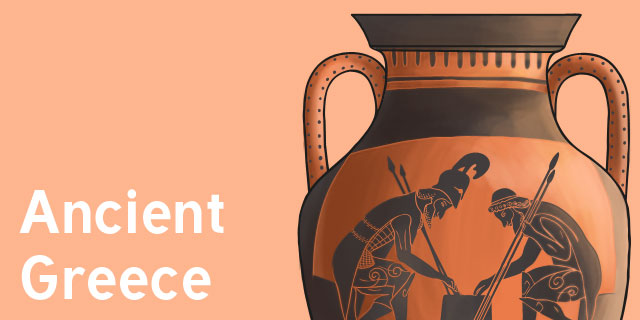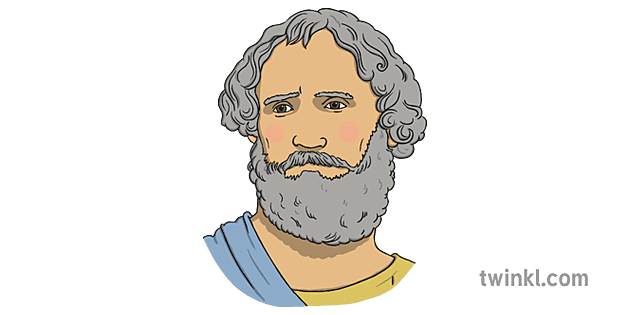



Archimedes, famously known as the man who said Eureka, was born in 287 B.C. and died in 212/211 B.C., is one of the most famous and intelligent mathematicians and inventors in history. He was born on the island of Sicily and spent the majority of his life in Syracuse, which was the main Greek city-state on the island. Archimedes was born into a wealthy family, so his father was able to make sure that Archimedes was well-educated. He sent a ten-year-old Archimedes to study in Alexandria, Egypt. Other than this, not much is known about the personal life of Archimedes.

Archimedes discovered several important principles during his mathematics career, but he also devoted a lot of time to the study of physics, engineering, and even warfare! Throughout his life, he was employed by wealthy citizens of Syracuse, kings, and even militaries to create inventions and solve problems for them.
Eureka is an Ancient Greek word meaning "I have found it." Most of us have heard the word eureka before, often in the context of someone making a new discovery, be that in real life, on TV, or somewhere else. But, the important question is, who said eureka first? Yep, that’s it, you guessed it, Archimedes was the first person to use the word eureka! So, why did this famous scientist and inventor exclaim "eureka" all those years ago?
It all started when Archimedes was asked to solve the gold crown problem (detailed below.) As part of this problem, Archimedes had to confront the idea of water displacement -which is when water is moved by an object that enters it. Using water displacement, he was able to solve the tricky gold crown problem, and he was overjoyed. He was so happy with his discovery that he wanted to tell the king straight away. Archimedes was in such a hurry that he didn’t even stop to put his clothes on. This meant that he ran through the streets of Syracuse completely naked, shouting "Eureka!"
As mentioned in the section above, Archimedes used water displacement to solve the difficult gold crown problem that was assigned to him by the king. After doing this, the famous inventor was so inspired by his discovery that he went on to write a book all about various floating objects, and how they are able to float. Archimedes’ book was aptly named, "On Floating Bodies" and is actually one of the earliest references to buoyancy in the whole of history. The principle of buoyancy is an extremely important part of our day-to-day lives, whether we realize it or not. For instance, even if you don’t personally like to sail, boats are required to transport a wide range of items, including food and other goods all around the world. Without these boats, you would not have access to some of your favorite things.
In addition to his discoveries surrounding buoyancy, Archimedes also played an integral role in laying the foundations for modern-day calculus. Calculus is essentially the study of change within the world of mathematics. Archimedes was also a pioneer in the field of mathematics and science in the way that he applied his mathematical findings to the physical world.
Archimedes often turned his immense skills to the fields of invention and engineering. He often made new tools and machines for the people of Syracuse. One of these inventions is still used to this day, it is called the Archimedes’ Screw and is used by farmers, factories, and other industries to lift water out of a pool and bring it to crops or other needs.
Some of his other most well-documented inventions include a method of measuring distance and a pulley system for lifting large ships with a single rope. Archimedes managed to create an accurate system of measurement using a cart with wheels that turned exactly 400 times in one mile. Using a little pin, the wheel would hit a gear with 400 teeth. This gear would then turn once every mile and drop a small stone into a cup each time. At the end of the journey, you could count the stones to know how many miles you had traveled.

The pulley system devised by Archimedes was employed to pull warships into docks and out of danger when they were damaged. Although, this was not Archimedes’ only contribution to the art of warfare.
Archimedes used his rope and pulley system to invent improved catapults that were employed regularly during the Punic Wars, between Rome and Carthage. Despite this assistance given to the Roman Empire in the form of new catapult technology, Archimedes was most loyal to his city of Syracuse. When Rome attacked the city of Syracuse, Archimedes designed two inventions that proved to be quite a thorn in the side of the Roman Empire. The first of them was "The Claw of Archimedes." It was made up of a series of iron claws in the water around Syracuse that were attached to ropes. When ships sailed close to the shore, the claws could be pulled up by wooden cranes. This would cause incredible damage to the ships and sometimes sink them completely.
 A catapult from ancient Greece.
A catapult from ancient Greece.
The second of Archimedes’ wartime inventions was a "heat ray." Yes, a "heat ray!" It is believed that Archimedes used a series of mirrors set along the coastline, that were all aimed at the same ship. The reflection of the sun would be multiplied from all the mirrors, causing intense heat on the ship and causing the wooden ships to burn.
After many years of war, the Roman Army managed to take the city of Syracuse. One of the Roman soldiers killed Archimedes, who was an old man at this time. It is believed that the Roman Emperor had ordered Archimedes to be captured alive and that killing him had been a mistake.
It is believed that Archimedes was killed whilst drawing a mathematical diagram in the sand on the floor of his home. He was so focused on his work that he did not see the soldier behind him. His last words were, "Don’t disturb my circles!"
The story of how Archimedes solved the gold crown problem is possibly the most famous one out there. It all took place in Syracuse, where Archimedes had a very close relationship with the king, Hiero II. One day, Hiero hired a goldsmith to make a pure gold crown for him. He gave the goldsmith a block of gold weighing a specific amount, which was to be used to make the crown. Once the crown was finished, Hiero weighed it and found that it was the same weight as the block of gold he had originally given the goldsmith. Technically, this meant that everything was fine and as it should be. However, Hiero was suspicious that the goldsmith had cheated him by mixing silver in with the gold to make the crown, keeping the leftover gold for himself.
Hiero was desperate to find out if he had been cheated, but had no clue how to go about it. At the time, the crown would have been shaped in the form of a wreath and was intended to be placed on the statue of a god or goddess. Therefore, because the crown was sacred, Hiero could not destroy it in his investigation of the goldsmith.

A gold laurel wreath.
This seemed like an impossible feat, so, he employed the help of his dear friend, Archimedes. Archimedes thought long and hard about how to solve this gold crown problem, but nothing came to him. Until, one night when Archimedes was having a bath, he had a revelation. The story goes that Archimedes stepped into the bath and caused it to overflow. This made him think. The water that had splashed out of the tub when he stepped in was equal to the volume taken up by his body. It was this discovery that provided Archimedes with the solution to King Hiero’s gold crown problem.
Archimedes was thrilled with his new discovery and rushed to tell the king what he had found. Once he got to King Hiero, he explained his ingenious solution. In order to find out whether the crown had been mixed with silver, a weight of gold equal to the crown was placed in a basin that is filled to the brim with water. Then, the gold was removed and replaced with King Hiero’s crown. If the water rose higher and overflowed with the crown in it, they could be certain that the goldsmith cheated Hiero. This is because, in order to make the crown weigh the same as the gold, the goldsmith would have had to make the crown larger, as silver weighs less than gold.
Sure enough, the crown was placed in the water and the basin overflowed, proving that the goldsmith had tampered with the crown by mixing silver into the gold.
As we know, Archimedes was the person who said eureka first, but he was not the last. Ever since this first exclamation, the word has become a popular form of expressing a breakthrough. The word has become so popular, in fact, that the term, "the eureka effect" has been coined among scientists. The eureka effect describes the human experience of suddenly understanding something that was previously deemed impossible to understand.
Psychologists have been studying the eureka effect and have come up with four defining features of the experience. When a person experiences a eureka moment, they will typically go through these four stages:
These four key stages do not always occur separately and in a sequence, as they have been laid out above. Sometimes, they are combined and can happen at the same time.
Psychologists have described the process of having an "aha" moment, as gaining sudden insight. The first stage of the process requires a person to experience a barrier or a block in their thinking. This barrier will create a point of impasse, stopping them from continuing their work, despite their best efforts to find a solution. Once they have reached this block, the "aha" moment can take place. This moment is never pre-planned but instead is always completely sudden and unexpected.

A lightbulb often used to portray the"eureka" or "aha" moment in popular culture.
Experts have researched the science behind the "aha" moment and have discovered that it comes as the result of a break in mental fixation. When a person is mentally fixated on something, they are so focused on a particular concept or thing that it becomes counterproductive to their progress. This can often happen when we spend too much time focusing on finding a solution to a particular problem. It is only when we break free from the constraints of this mental fixation, that we are able to think outside the box and potentially have an "aha" moment of our own.
Archimedes was a renowned mathematician, inventor, scientist, and philosopher whose work has had a massive impact on how we live today. Here are 7 of Archimedes’ greatest discoveries and contributions to the world of mathematics:
If you want to know more about Archimedes and his incredible mathematical discoveries, we have tons of amazing resources to help you out.
Engage students with this leveled nonfiction fact file about Archimedes that includes three follow-up vocabulary questions that can be used as a quick assessment or exit ticket. The informational text and vocabulary questions are appropriately complex for the grade.
Honor the coolest mathematical constant and one of Archimedes' important contributions to math in the most delicious way possible with our Pi Day Apple Pie Classroom Recipe! It’s the perfect addition to your recipe books, combining math and munchies in one fantastic activity for kids.
Rewind the clocks 2,500 years and take your students on a journey back in time, from the beginning to the end of one of the most influential civilizations in history, Ancient Greece. Perfect for upper-grade social studies lessons, this Ancient Greece PowerPoint for kids is a great way of bringing world history learning to life!